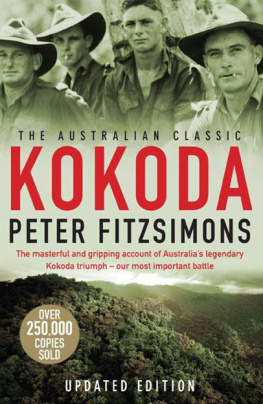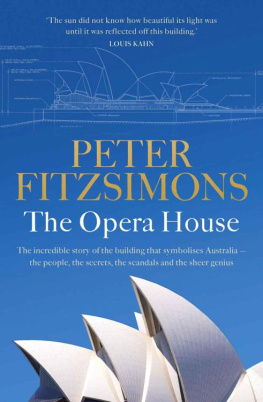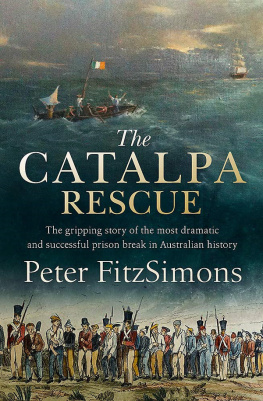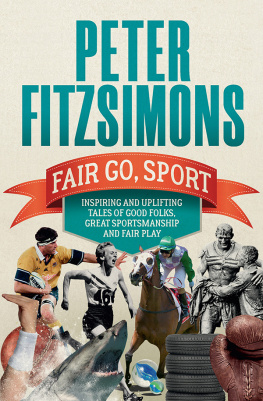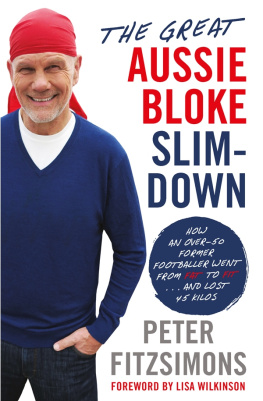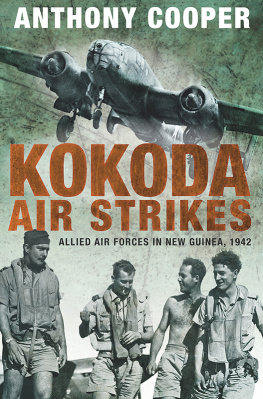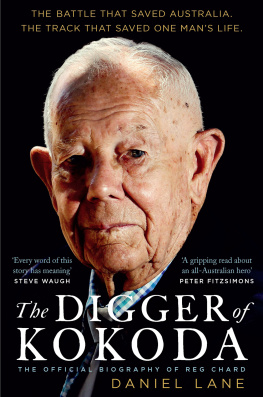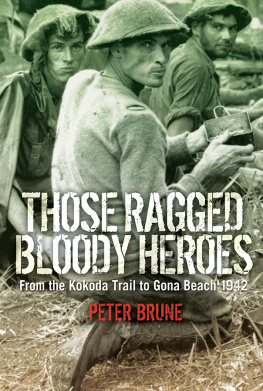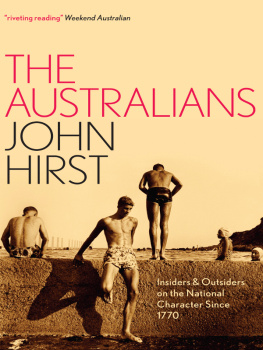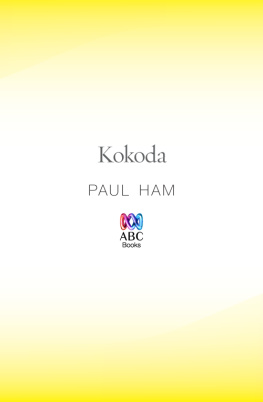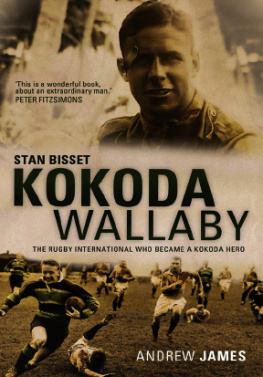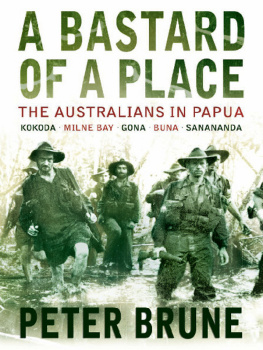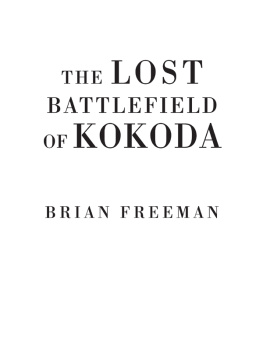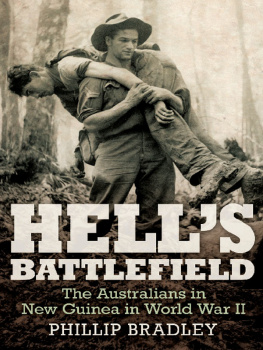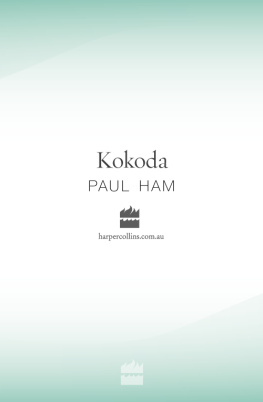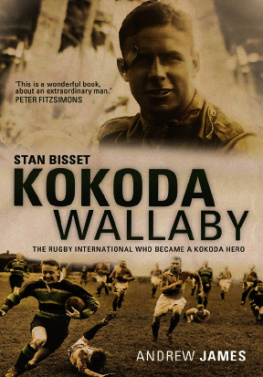| Kokoda |
| Fitzsimons, Peter |
| Hachette Littlehampton (2010) |
The Australians who served here in Papua New Guinea fought and died, not for defence of the old world, but the new world. Their world. They died in defence of Australia and the civilisation and values which had grown up there. That is why it might be said that, for Australians, the battles in Papua New Guinea were the most important ever fought. Former Prime Minister Paul Keating, Bomana War
Cemetery, Port Moresby, Anzac Day, 1992
Basking in Beirut
Little Theories of Life
Hitchhiking for Ugly People
Rugby Stories
Everyone But Phar Lap
Everyone And Phar Lap
Nick Farr-Jones: The Authorised Biography
FitzSimons on Rugby
Beazley: A Biography
Nene
Nancy Wake: A Biography of Our Greatest War Heroine
The Rugby War
John Eales: The Biography
The Story of Skilled Engineering and Frank Hargrave
Tobruk
The Ballad of Les Darcy
Charles Kingsford Smith and Those Magnificent Men
KOKODA
PETER FITZSIMONS

Every effort has been made to acknowledge and contact the owners of copyright for permission to reproduce material which falls under the 1968 Copyright Act. Any copyright owners who have inadvertently been omitted from acknowledgments and credits should contact the publisher and omissions will be rectified in subsequent editions.

First published in Australia and New Zealand in 2004
by Hodder Australia
(an imprint of Hachette Australia Pty Limited)
Level 17, 207 Kent Street, Sydney NSW 2000
www.hachette.com.au
This updated edition published 2010
Copyright Peter FitzSimons 2004, 2010
This book is copyright. Apart from any fair dealing for the purposes of private study, research, criticism or review permitted under the Copyright Act 1968 , no part may be stored or reproduced by any process without prior written permission. Enquiries should be made to the publisher.
A CIP catalogue record of this book is available from the National Library of Australia.
978 0 7336 1962 5
978 0 7336 2606 7 (ebook edition)
Maps by Kinart
Front cover image courtesy of AWM 061859
Front and back cover image courtesy of The Australian Picture Library
Cover design by Nada Backovic
To my late parents, Lieutenant Peter McCloy FitzSimons and Lieutenant Beatrice Helen Booth, both of whom proudly served with the AIF in New Guinea: my mother at Lae, helping to put back together some of the men who were wounded in the Kokoda campaign, and my father at Finschafen and Dumpu in the actions which followed it, after he had previously served in the Middle East and North Africa.
And to all the warriors of the Kokoda Track and Milne Bay including my fathers late twin brother, James Marsden FitzSimons, who fought in the final stages of the Kokoda campaign in the clean-up at Buna with the 2/6th Field Regiment.
Finally, I dedicate this book to the brave war correspondents and cinematographers of both sides who first documented this extraordinary saga, thus ensuring that the story can be told to the generations to come. I cite particularly the greats: Osmar White, Chester Wilmot and Damien Parer from Australia, and Japans Seizo Okada, who was with his forces throughout their campaign.
Contents
It was on a bitterly hot and humid morning on the outskirts of Port Moresby in the early days of September 1942. As sweat trickled down his exhausted, shaking armsand occasionally to the very fingertips he was pecking at his typewriter with, the great ABC Correspondent Chester Wilmot tried to give some sense to just what it was that he had so recently seen
He wrote:
One day late in August we stood on a spur of the Owen Stanleys and looked down the deep valley which leads to Kokoda, five thousand feet below. All we could see was a blanket of dark green treetops broken only here and there by the white waters of the turbulent creek at the bottom. The valley was almost as deep as it was wide and its sides swept up from the creekbed steeply and in some places precipitously. Somewhere under those treetops wound the track which leads from Kokoda up the valley and over the range to Port Moresby. And two miles away somewhere under those treetops in the dark damp forest Australian and Japanese troops were fighting desperately for the possession of this track. It didnt look much to fight for. It was just a series of muddy footholds in the mountain side so slippery that you had to sling your rifle and leave your hands free to grab the nearest vine or branch as your feet slid from under you so steep that in some places you could scale the mountain face only by using both hands and both feet so muddy that at times you sloshed through a quagmire more than ankle deep and felt the cloying mud suck your feet back at every step. That was the track they were fighting for down there
Looking at what he had written, it was all Wilmot could do not to weep. Given his recent experience, he couldnt even be sure that this report would make it onto the airwaves before it was quietly killed in the night by the authorities, but it changed nothing of the question that kept gnawing at him All that valour, all that courage, all those lives lost. How, how had it come to this? How was it that such a small number of Australian men without much of a military background had been thrown up against a vastly superior, superbly trained Japanese force when the fate of Australia might very well be hanging in the balance?
In the spring of 2001, I was taken to lunch by Matthew Kelly of Hodder Headline. He came to the point fairly quickly. On the strength of the success of the book Id written on the war heroine Nancy Wake, aka the White Mouse, he would like me to write a book on the Kokoda Track.
My answer was succinct: No.
Even though my Uncle Jim had fought on the Kokoda Track and both my mother and father had served in New Guinea in WWII, like most Australians I only had a foggy idea what the fighting along the Kokoda Track had been all about. Sure, I knew our blokes had gone up against the Japaneseand I gathered that they had done pretty wellbut that was close to all I knew. Only a short time later, though, I was having lunch with my friend Daniel Petre and mentioned the Kokoda offer to him.
Daniel fired up in a manner I have rarely seen. Usually a very calm, considered kind of bloke, he was insistent. I had to do this book. Did I have any idea how extraordinary the story was, what had been achieved there? No? Well let me tell you
In another conversation shortly afterwards with my former biographical subject Kim Beazleya military aficionado to beat them all who, among other things, had been this countrys longtime defence ministerhe said that in his view the fighting on the Kokoda Track was some of the toughest in the course of all human conflict. Kim began to add some fascinating details, reeled off the names of five books I should read to get a grasp of it, and promptly sent me two of them.
And things moved from there. Once bitten by the same Kokoda bug that had got to Matthew, Daniel and Kim, I soon embarked and have been on the case ever since. In November of 2002, I was with Daniel and sixteen mates on the Kokoda Track itself, pushing hard from Owers Corner to Kokoda in a little under six days and surviving, just, the hardest physical ordeal of my life. My respect for what had been achieved there by the soldiers of the 39th Battalion, the 2/14th, 2/16th and others, now knew no bounds, and though with every tortuous step up the towering Maguli Ranges I swore I would never set foot there again, I know Ill go back, perhaps at the point when my now young children are strong enough to accompany me, and I am not too weak to accompany them.
Next page
